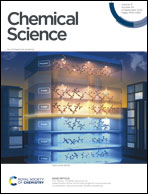Subcomponent self-assembly of circular helical Dy6(L)6 and bipyramid Dy12(L)8 architectures directed via second-order template effects†
Abstract
In situ metal-templated (hydrazone) condensation also called subcomponent self-assembly of 4,6-dihydrazino-pyrimidine, o-vanillin and dysprosium ions resulted in the formation of discrete hexa- or dodecanuclear metallosupramolecular Dy6(L)6 or Dy12(L)8 aggregates resulting from second-order template effects of the base and the lanthanide counterions used in these processes. XRD analysis revealed unique circular helical or tetragonal bipyramid architectures in which the bis(hydrazone) ligand L adopts different conformations and shows remarkable differences in its mode of metal coordination. While a molecule of trimethylamine acts as a secondary template that fills the void of the Dy6(L)6 assembly, sodium ions take on this role for the formation of heterobimetallic Dy12(L)8 by occupying vacant coordination sites, thus demonstrating that these processes can be steered in different directions upon subtle changes of reaction conditions. Furthermore, Dy6(L)6 shows an interesting spin-relaxation energy barrier of 435 K, which is amongst the largest values within multinuclear lanthanide single-molecular magnets.



 Please wait while we load your content...
Please wait while we load your content...